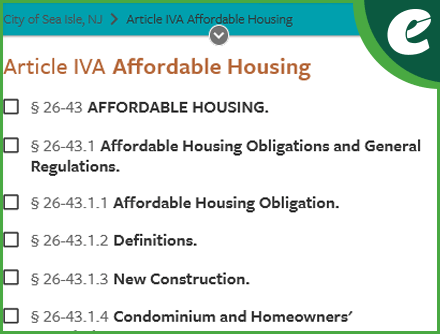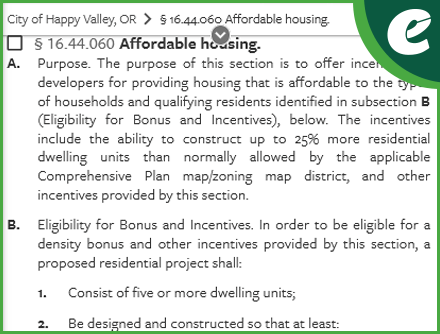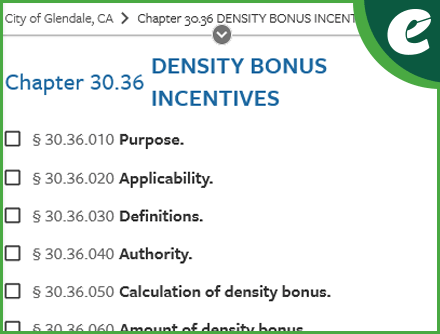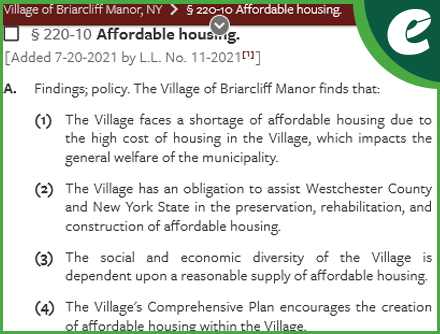Affordable housing is a crisis-level issue affecting most communities across the United States. A key strategy for local governments seeking to address these challenges is zoning reform – specifically upzoning.
View sample upzoning legislation >
Zoning and its impact on housing
Zoning laws regulate land use in municipalities, determining what types of buildings can be constructed and where they can be located. Traditional zoning can often restrict the development of affordable housing by limiting density, enforcing minimum lot sizes, and isolating residential land uses from other desirable amenities such as entertainment venues, restaurants, and retail stores.
A movement to reform zoning laws is on the rise to create more inclusive and affordable communities and is often coupled with initiatives such as creating more walkable, pedestrian-friendly communities like we saw in the first half of the 20th century America. One method that’s gaining momentum is upzoning.
What is upzoning?
Upzoning refers to the process of changing or reforming zoning laws to allow for higher-density development. This means areas previously zoned for single-family homes may be rezoned to permit multi-family units, such as duplexes, townhouses, and apartment buildings. The primary goal of upzoning is to increase housing supply, which can help reduce housing costs and accommodate growing populations.
A growing need
Urban areas worldwide are experiencing unprecedented population growth, leading to increased demand for housing. It’s estimated that the world’s population that lives in urban areas is expected to grow from 55 to 68 percent by mid-century.
While upzoning doesn’t necessarily create new housing, the process removes a significant barrier to building new housing and can greatly incentivize new housing development projects. For instance, enacting zoning reform in areas where existing water and sewer infrastructure already exists can help developers to reduce costs and make such projects more enticing. Providing a zoning framework for more efficient land use increases the potential to ease the housing crunch and make urban areas that are more walkable, affordable, and livable.
Upzoning legislation in action
Minneapolis 2040 Plan
Minneapolis made news in 2018 with its comprehensive upzoning initiative, the Minneapolis 2040 plan. The city eliminated single-family zoning, allowing triplexes on all residential lots. This move was aimed at combating housing shortages, promoting affordability, and encouraging inclusion of diverse demographics. Early analysis suggests that the policy has started to increase housing options and diversity in neighborhoods.
Oregon’s Statewide Upzoning
In 2019, Oregon passed what many call a landmark law mandating upzoning in cities with over 10,000 residents. The law requires cities to allow duplexes, triplexes, and fourplexes in areas traditionally zoned for single-family homes. This state-level approach underscores the potential of upzoning to address housing shortages on a broader scale.
New Rochelle, NY, Downtown Overlay Zone (DOZ)
The City of New Rochelle rezoned nearly 300 acres of its downtown area to encourage the development of mixed-use residential and commercial development. As part of the DOZ, all projects are required to provide 10 percent of residential square footage as affordable for households at 80 percent of the Area Median Income (AMI), or to pay into the city’s Affordable Housing Fund according to a set formula.
Benefits of upzoning
- Increased Housing Supply
By allowing higher-density development, upzoning can significantly boost the housing supply. More units on the same land can help meet the needs of growing urban populations, potentially stabilizing, or reducing housing prices. - Improved Affordability
As an economic rule of thumb, increased supply often leads to lower prices. Upzoning can boost the creation of more affordable housing options by diversifying the types of available units and allowing a greater quantity of units. - Environmental Sustainability
Higher-density development supports more sustainable urban growth. It can reduce urban sprawl, decrease reliance on cars, and promote the use of public transportation. Additionally, compact cities tend to have lower per capita greenhouse gas emissions.
Challenges of upzoning legislation
The benefits of upzoning are many, but in order to be successful in the zoning reform process, municipal leaders and developers should be mindful that some concerns do exist and should be considered.
- Community Opposition
Upzoning can face significant opposition from residents who fear increased density will change a neighborhood’s character, lead to overcrowding, or burden its infrastructure. Addressing these concerns requires careful planning and earnest community engagement. - Infrastructure Strain
Increased density can put pressure on existing infrastructure, including roads, schools, transportation, and other public services. Municipalities should evaluate upfront the potential necessity of upgrading infrastructure to support higher population densities. - Gentrification Concerns
While upzoning can increase housing supply, if not managed well, it may also lead to the displacement of low-income residents. Policymakers should consider how best to balance upzoning with measures to protect vulnerable populations.
Additional local government strategies
As part of the upzoning implementation process, local governments may explore coupling zoning reform with other types of incentives.
Inclusionary Zoning: Many municipalities pair upzoning with inclusionary zoning policies, which require developers to include a certain percentage of affordable units in new developments. This can ensure that upzoning benefits a broader range of residents.
Density Bonuses: Density bonuses incentivize developers to build affordable housing by allowing them to construct more units than normally permitted.
Community Land Trusts: Community land trusts (CLTs) can help mitigate gentrification by ensuring that land remains affordable for housing. CLTs own land and lease it to homeowners, keeping housing prices stable and affordable over the long term.
A promising approach
By revising zoning laws to allow higher-density development, local governments can increase housing supply, improve affordability, and support sustainable growth. However, successful implementation requires addressing community concerns, upgrading infrastructure, and protecting vulnerable populations. As more municipalities embrace upzoning legislation, it will be essential to monitor outcomes and share best practices to maximize the benefits of this innovative housing strategy.
Useful examples of upzoning legislation from the eCode360® Library
If your community is considering enacting or updating zoning ordinances to address housing issues in your community, some useful examples can be found in our eCode360 Library, including:
Is your code on a schedule?
Did you know you can set up a regular update schedule, so you don’t have to worry about compiling materials or taking up time and resources of your staff to do the updates yourself? As your municipality passes legislation, send it to General Code and we’ll take care of the rest. It’s just that simple!
For tips that will allow us to process your code updates most efficiently, click here.
Questions about updating your code?
Our Client Care team is available to explain the options and benefits of scheduled code updates or any other code-related questions you might have.
Sources:
- Upzones: What are they and what do they do?
- Addressing Challenges to Affordable Housing in Land Use Law: Recognizing Affordable Housing as a Right
- What Is Upzoning, and Why Does It Matter for Progress on SDGs?
- Upzoning and Mandatory Affordable Housing
- Minneapolis 2040 Plan
- Oregon’s Statewide Upzoning
- New Rochelle, NY, Downtown Overlay Zone (DOZ)
- What Is Area Median Income (AMI)? – HUD Loans
- Gentrification
- Inclusionary Zoning
- Inclusionary Zoning and Mixed-Income Communities
- Community Land Trusts
- Compact cities to address climate change
- Upzoning Modestly Increases Housing Supply and Affordability, Study Says
- Why’s everyone talking about upzoning? It’s the foundation of green, equitable cities.
- eCode360® Library of municipal codes






